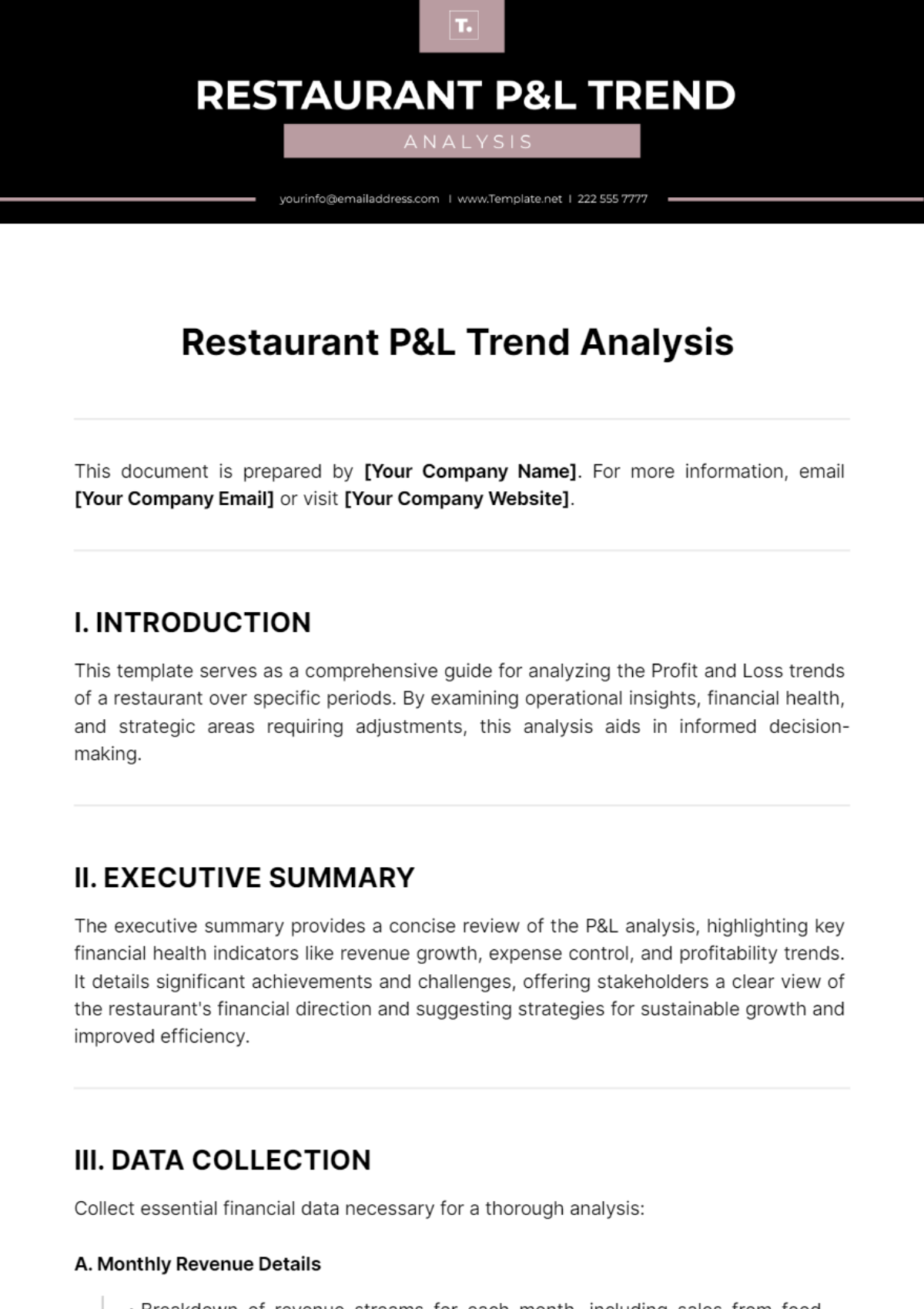Restaurant P&L Trend Analysis
This document is prepared by [Your Company Name]. For more information, email [Your Company Email] or visit [Your Company Website].
I. INTRODUCTION
This template serves as a comprehensive guide for analyzing the Profit and Loss trends of a restaurant over specific periods. By examining operational insights, financial health, and strategic areas requiring adjustments, this analysis aids in informed decision-making.
II. EXECUTIVE SUMMARY
The executive summary provides a concise review of the P&L analysis, highlighting key financial health indicators like revenue growth, expense control, and profitability trends. It details significant achievements and challenges, offering stakeholders a clear view of the restaurant's financial direction and suggesting strategies for sustainable growth and improved efficiency.
III. DATA COLLECTION
Collect essential financial data necessary for a thorough analysis:
A. Monthly Revenue Details
Breakdown of revenue streams for each month, including sales from food, beverages, and other revenue sources.
Identification of any notable trends or seasonality, such as fluctuations due to holidays or special events.
Analysis of top-performing and underperforming revenue categories to identify areas for improvement.
B. Monthly Expense Records
Detailed records of expenses categorized into operational expenses (e.g., Food, Labor, Rent, Utilities) and discretionary expenses.
Comparison of expenses across different months to identify any anomalies or areas of overspending.
C. Adjustments and One-Time Costs
IV. ANALYSIS BREAKDOWN
A. Revenue Analysis
Summary of total revenue per month, highlighting any significant changes or growth patterns.
Assessment of revenue trends and seasonality to anticipate future performance.
Identification and analysis of top-performing and underperforming revenue categories to inform strategic decisions.
B. Expense Analysis
Detailed breakdown of significant expenses by category, including variable and fixed costs.
Calculation of percentage change in each expense category over the analyzed period to assess cost management effectiveness.
C. Profitability Assessment
Evaluation of Gross Profit Margin to measure operational efficiency.
Analysis of trends in Net Profit Margin to gauge overall profitability.
Assessment of external factors impacting profitability, such as market competition or regulatory changes.
V. COMPARATIVE ANALYSIS
Comparison of current data against previous periods and industry benchmarks to evaluate performance:
Benchmarking against historical data to identify trends and deviations.
Comparison with industry standards to assess competitiveness and identify areas for improvement.
Utilization of key performance indicators (KPIs) to measure progress and set targets for future performance.
VI. RECOMMENDATIONS
Strategies for optimizing costs, enhancing revenue, and mitigating risks based on the analyzed data and insights gained:
Cost optimization strategies, such as renegotiating supplier contracts or implementing energy-saving measures.
Revenue enhancement tactics, such as introducing new menu items or implementing targeted marketing campaigns.
Risk mitigation measures, such as diversifying revenue streams or implementing contingency plans for unforeseen events.
VII. APPENDICES
Inclusion of referenced documents, extended data tables, or detailed financial reports supporting the analysis. This may include:
Detailed breakdowns of revenue and expense categories.
Charts or graphs illustrating trends and patterns.
Supporting documentation for any one-time costs or adjustments mentioned in the analysis.
Analysis Templates @ Template.net






























